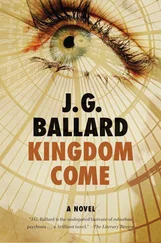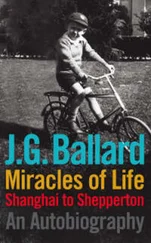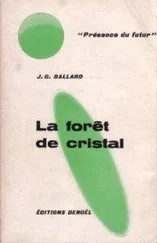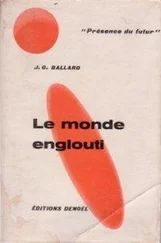Above him, the inverted motorcycle fell on to the car’s roof. Its handlebars passed through the empty windshield and decapitated the front-seat passenger. The front wheel and chromium fork assembly plunged through the roof, the whiplashing drive chain severing the cyclist’s head as he swept past. The pieces of his disintegrating body rebounded off the rear wheel-housing of the car and passed over the ground in the haze of broken safety glass which fell like ice from the car, as if it had been defrosted after a long embalming. Meanwhile, the driver of the car had rebounded off the collapsing steering wheel and was sliding beneath the column into the lower compartment of the car. His decapitated wife, hands raised prettily in front of her neck, rolled against the instrument panel. Her detached head bounced off the vinyl seat covering and passed between the torsoes of the children in the rear seat. Brigitte, the smaller of the two children, lifted her face to the roof of the car and raised her hands in a polite gesture of alarm as her mother’s head struck the rear window and cannonaded around the car before exiting through the left-hand door.
The car slowly came to rest, continuing to heave itself laboriously off the ground. The four passengers subsided into the glass-embroidered cabin space. Their signalling limbs, busy with an encyclopedia of unheeded semaphores, settled again into a crudely human posture. Around them, the fountain of frosted glass moved away for the last time.
The audience of thirty or so visitors stared at the screen, waiting for something to happen. As we watched, our own ghostly images stood silently in the background, hands and faces unmoving while this slow-motion collision was re-enacted. The dream-like reversal of roles made us seem less real than the mannequins in the car. I looked down at the silk-suited wife of a Ministry official standing beside me. Her eyes watched the film with a rapt gaze, as if she were seeing herself and her daughters dismembered in the crash.
The visitors wandered away to the tea tent. I followed Vaughan towards the crashed car. He stepped between the chairs, spitting his chewing-gum on to the grass. I knew that he had been even more affected by the test crash and the slow-motion film than myself. Helen Remington watched us, sitting alone among the chairs. Vaughan stared down at the shattered car, almost about to embrace it. His hands roved along the torn bonnet and roof, the muscles of his face opening and shutting like manacles. He bent down and peered into the cabin, scanning each of the mannequins. I waited for him to say something to them, my eyes moving from the dented curvatures of the bonnet and fenders to the cleft of Vaughan’s buttocks. The destruction of this motor-car and its occupants seemed, in turn, to sanction the sexual penetration of Vaughan’s body; both were conceptualized acts abstracted from all feeling, carrying any ideas or emotions with which we cared to freight them.
Vaughan scraped the flaking fibreglass from the driver’s face. He wrenched the door open and edged his thigh on to the seat, one hand holding the distorted steering wheel.
‘I’ve always wanted to drive a crashed car.’
I took the remark to be a joke, but Vaughan appeared to mean it seriously. Already he was calmer, as if this act of violence had drained some of the tensions from his body, or pre-empted whatever violent behaviour he had suppressed for so long.
‘All right,’ Vaughan announced, dusting the fibreglass from his hands. ‘We’ll leave now—I’ll give you a lift.’ When I hesitated he said, ‘Believe me, Ballard, one car-crash looks like another.’
Was he aware that I was duplicating in my mind a series of sexual postures between Vaughan and myself, Helen Remington and Gabrielle which would re-enact the death-ordeals of the mannequins and the fibreglass motorcyclist? In the urinal beside the car-park Vaughan deliberately exposed his half-erect penis as he stood well back from the stall, flicking out the last drops of urine on to the tiled floor.
Once away from the Laboratory he recovered all his aggressiveness, as if bis appetite was quickened by the passing cars. He rolled the heavy car along the access road to the motorway, holding the battered bumpers a few feet behind any smaller vehicle until it moved out of his way.
I tapped the instrument panel. ‘This car—a ten-year-old Continental. I take it that you see Kennedy’s assassination as a special kind of car-crash?’
‘The case could be made.’
‘But why Elizabeth Taylor? Driving around in this car, aren’t you putting her in some danger?’
‘Who from?’
‘Seagrave—the man’s half out of his mind.’
I watched him drive along the last stretches of the motorway, making no effort to slacken his speed despite the warning signs.
‘Vaughan—has she ever been in a car-crash?’
‘Not a major crash—it means that everything lies in the future for her. With a little forethought she could die in a unique vehicle collision, one that would transform all our dreams and fantasies. The man who dies in that crash with her…’
‘Does Seagrave appreciate this?’
‘In his own way.’
We approached a major trunk roundabout. For almost the first time since we had left the Road Research Laboratory Vaughan applied the brakes. The heavy car swayed and went into a long right-hand slide which carried it across the path of a taxi already making its way around the island. Flooring the accelerator, Vaughan swerved in front of it, tyres screaming over the blaring horn of the taxi. He shouted through his open window at the driver and pressed on towards the narrow canyon of the northbound slip road.
As we settled down Vaughan reached behind him and lifted a briefcase off the back seat.
‘I’ve been testing people for the programme with these questionnaires. Tell me if I’ve left anything out.’
As the heavy car moved through the London-bound traffic I began to read the questionnaires which Vaughan had prepared. The subjects who had completed the forms represented a cross-section of Vaughan’s world: two computer programmers from his former laboratory, a young dietitian, several airport stewardesses, a medical technician at Helen Remington’s clinic, as well as Sea-grave and his wife Vera, the television producer and Gabrielle. From the brief curriculum vitae elicited from each subject I saw, as I expected, that they had all at some time been involved in a minor or major automobile crash.
In each questionnaire the subject was given a list of celebrities from the worlds of politics, entertainment, sport, crime, science and the arts, and invited to devise an imaginary car-crash in which one of them might die. Scanning the list offered, I saw that most of the figures were still alive; a few were dead, some of these in auto-crashes. The names gave the impression of having been picked at random from a quick recall of newspaper and magazine headlines, television newscasts and documentaries.
By contrast, the choice of wounds and death-modes available showed all the benefits of an exhaustive and lingering research. Almost every conceivable violent confrontation between the automobile and its occupants was listed: mechanisms of passenger ejection, the geometry of kneecap and hip-joint injuries, deformation of passenger compartments in head-on and rear-end collisions, injuries sustained in accidents at roundabouts, at trunk-road intersections, at the junctions between access roads and motorway intersections, the telescoping mechanisms of car-bodies in front-end collisions, abrasive injuries formed in roll-overs, the amputation of limbs by roof assemblies and door sills during roll-over, facial injuries caused by dashboard and window trim, scalp and cranial injuries caused by rear-view mirrors and sun-visors, whiplash injuries in rear-end collisions, first and second-degree burns in accidents involving the rupture and detonation of fuel tanks, chest injuries caused by steering column impalements, abdominal injuries caused by faulty seat-belt adjustment, second-order collisions between front-seat and rear-seat passengers, cranial and spinal injuries caused by ejection through windshields, the graded injuries to the skull caused by variable windshield glasses, injuries to minors, both children and infants in arms, injuries caused by prosthetic limbs, injuries caused within cars fitted with invalid controls, the complex self-amplifying injuries of single and double amputees, injuries caused by specialist automobile accessories such as record players, cocktail cabinets and radiotelephones, the injuries caused by manufacturers’ medallions, safety belt pinions and quarter-window latches.
Читать дальше
Конец ознакомительного отрывка
Купить книгу







